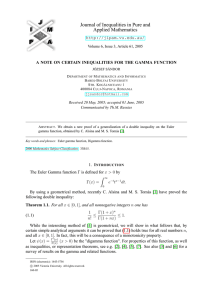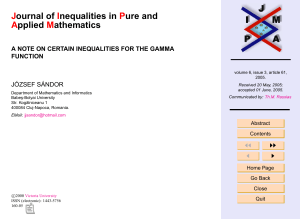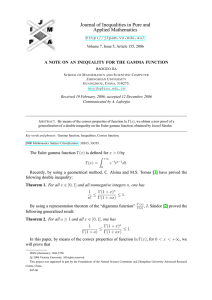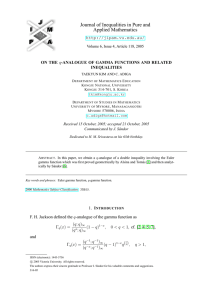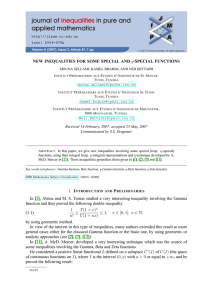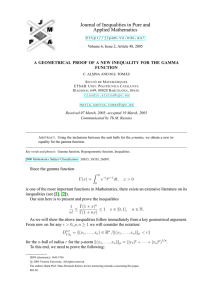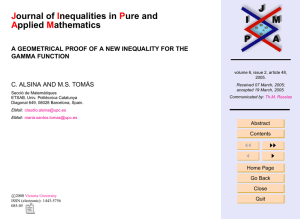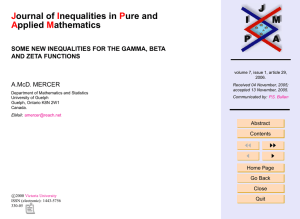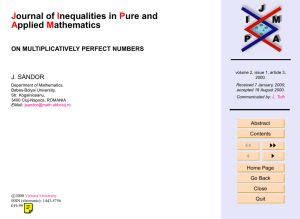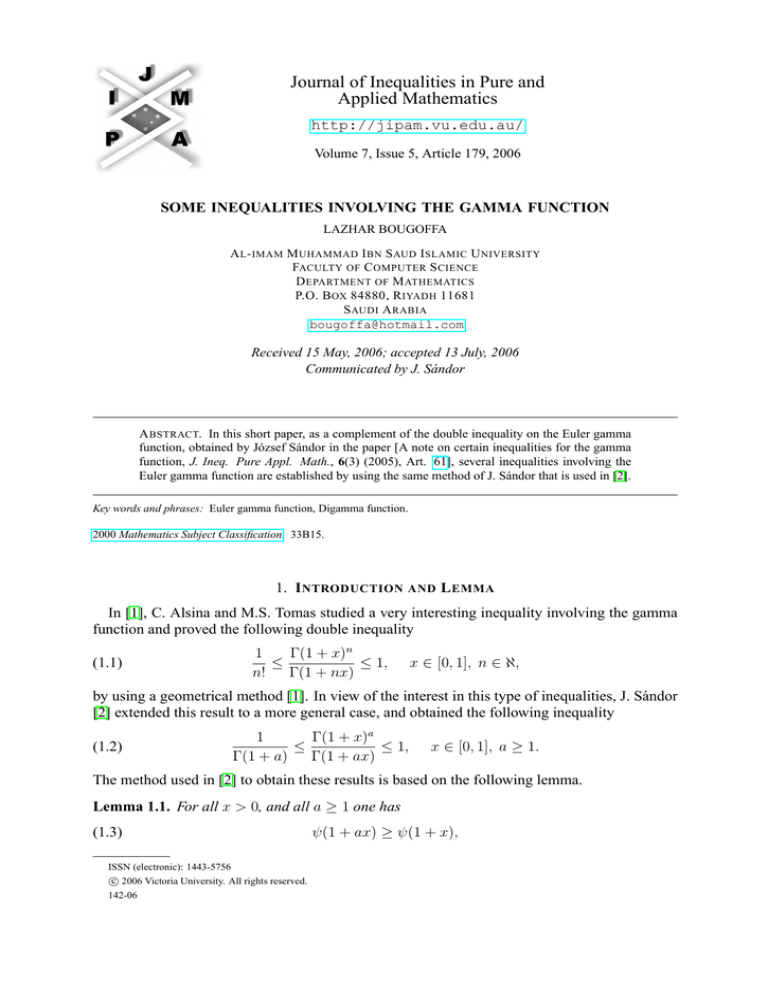
Journal of Inequalities in Pure and
Applied Mathematics
http://jipam.vu.edu.au/
Volume 7, Issue 5, Article 179, 2006
SOME INEQUALITIES INVOLVING THE GAMMA FUNCTION
LAZHAR BOUGOFFA
A L - IMAM M UHAMMAD I BN S AUD I SLAMIC U NIVERSITY
FACULTY OF C OMPUTER S CIENCE
D EPARTMENT OF M ATHEMATICS
P.O. B OX 84880, R IYADH 11681
S AUDI A RABIA
bougoffa@hotmail.com
Received 15 May, 2006; accepted 13 July, 2006
Communicated by J. Sándor
A BSTRACT. In this short paper, as a complement of the double inequality on the Euler gamma
function, obtained by József Sándor in the paper [A note on certain inequalities for the gamma
function, J. Ineq. Pure Appl. Math., 6(3) (2005), Art. 61], several inequalities involving the
Euler gamma function are established by using the same method of J. Sándor that is used in [2].
Key words and phrases: Euler gamma function, Digamma function.
2000 Mathematics Subject Classification. 33B15.
1. I NTRODUCTION AND L EMMA
In [1], C. Alsina and M.S. Tomas studied a very interesting inequality involving the gamma
function and proved the following double inequality
(1.1)
1
Γ(1 + x)n
≤
≤ 1,
n!
Γ(1 + nx)
x ∈ [0, 1], n ∈ ℵ,
by using a geometrical method [1]. In view of the interest in this type of inequalities, J. Sándor
[2] extended this result to a more general case, and obtained the following inequality
(1.2)
1
Γ(1 + x)a
≤
≤ 1,
Γ(1 + a)
Γ(1 + ax)
x ∈ [0, 1], a ≥ 1.
The method used in [2] to obtain these results is based on the following lemma.
Lemma 1.1. For all x > 0, and all a ≥ 1 one has
(1.3)
ISSN (electronic): 1443-5756
c 2006 Victoria University. All rights reserved.
142-06
ψ(1 + ax) ≥ ψ(1 + x),
2
L AZHAR B OUGOFFA
where ψ(x) =
Γ0 (x)
,
Γ(x)
x > 0 is the digamma function and has the following series representation
ψ(x) = −γ + (x − 1)
(1.4)
∞
X
k=0
1
.
(k + 1)(x + k)
Proof. See [2].
In [3], A.McD. Mercer continued to create new inequalities on this subject and other special
functions and obtained the following inequalities
Γ(1 + y)a
Γ(1 + x)a
(1.5)
<
, 0 < a < 1,
Γ(1 + ax)
Γ(1 + ay)
Γ(1 + x)a
Γ(1 + y)a
>
, a < 0 or a > 1,
Γ(1 + ax)
Γ(1 + ay)
where y > x > 0, 1 + ax > 0, and 1 + bx > 0.
This paper is a continuation of the above papers. As in [2], our goal is to prove several
inequalities involving the gamma function, using the same method of J. Sándor that is used in
[2]. Here, the essential lemma is the following
(1.6)
Lemma 1.2. For all x > 0, and all a ≥ b we have
(1.7)
ψ(1 + ax) ≥ ψ(1 + bx),
in which 1 + ax > 0 and 1 + bx > 0.
Proof. By the above series representation of ψ, observe that:
∞ X
ax
bx
−
,
ψ(1 + ax) − ψ(1 + bx) =
(k
+
1)(ax
+
k
+
1)
(k
+
1)(bx
+
k
+
1)
k=0
ψ(1 + ax) − ψ(1 + bx) = (a − b)x
∞
X
k=0
1
≥ 0,
(ax + k + 1)(bx + k + 1)
by a ≥ b, 1 + ax > 0, 1 + bx > 0, x > 0 and k > 0. Thus the inequality (1.7) is proved. The
equality in (1.7) holds only if a = b.
2. M AIN R ESULTS
Now we are in a position to give the following theorem.
Theorem 2.1. Let f be a function defined by
Γ(1 + bx)a
f (x) =
, ∀x ≥ 0,
Γ(1 + ax)b
in which 1 + ax > 0 and 1 + bx > 0, then for all a ≥ b > 0 or 0 > a ≥ b (a > 0 and b < 0), f
is decreasing (increasing) respectively on [0, ∞).
Proof. Let g be a function defined by
g(x) = log f (x) = a log Γ(1 + bx) − b log Γ(1 + ax),
then
g 0 (x) = ab[ψ(1 + bx) − ψ(1 + ax)].
By Lemma 1.2, we get g 0 (x) ≤ 0 if a ≥ b > 0 or 0 > a ≥ b (g 0 (x) ≥ 0 if 0 > a ≥ b), i.e., g
is decreasing on [0, ∞) (increasing on [0, ∞)) respectively. Hence f is decreasing on [0, ∞) if
J. Inequal. Pure and Appl. Math., 7(5) Art. 179, 2006
http://jipam.vu.edu.au/
S OME I NEQUALITIES I NVOLVING THE G AMMA F UNCTION
3
a ≥ b > 0 or 0 > a ≥ b (increasing if a > 0 and b < 0) respectively.
The proof is complete.
Corollary 2.2. For all x ∈ [0, 1], and all a ≥ b > 0 or 0 > a ≥ b, we have
Γ(1 + b)a
Γ(1 + bx)a
(2.1)
≤
≤ 1.
Γ(1 + a)b
Γ(1 + ax)b
Proof. To prove (2.1), applying Theorem 2.1, and taking account of Γ(1) = 1 we get f (1) ≤
f (x) ≤ f (0) for all x ∈ [0, 1], and we omit (2.1).
Corollary 2.3. For all x ∈ [0, 1], and all a > 0 and b < 0, we have
Γ(1 + b)a
Γ(1 + bx)a
(2.2)
1≤
≤
.
Γ(1 + ax)b
Γ(1 + a)b
Proof. Applying Theorem 2.1, we get f (0) ≤ f (x) ≤ f (1) for all x ∈ [0, 1], and we omit
(2.2).
Now we consider the simplest cases of Corollary 2.2 to obtain the known results of C. Alsina
and M.S. Tomas [1] and J. Sándor [2].
Remark 2.4. Taking a = n and b = 1 (a ≥ 1 and b = 1), in Corollary 2.2, we obtain (1.1)
((1.2)) respectively.
Also we conclude different generalizations of (1.5)–(1.6) which are obtained by A.McD.
Mercer [3].
Corollary 2.5. For all x ∈ [0, 1], and all a ≥ b > 0 or 0 > a ≥ b, we have
Γ(1 + bx)a
Γ(1 + by)a
<
,
(2.3)
Γ(1 + ax)b
Γ(1 + ay)b
where 0 < y < x ≤ 1.
Corollary 2.6. For all x ∈ [0, 1], and all a > 0 and b < 0, we have
Γ(1 + by)a
Γ(1 + bx)a
(2.4)
<
,
Γ(1 + ay)b
Γ(1 + ax)b
where 0 < y < x ≤ 1.
R EFERENCES
[1] C. ALSINA AND M.S. TOMAS, A geometrical proof of a new inequality for the gamma function, J. Ineq. Pure Appl. Math., 6(2) (2005), Art. 48. [ONLINE: http://jipam.vu.edu.au/
article.php?side=517].
[2] J. SÁNDOR, A note on certain inequalities for the gamma function, J. Ineq. Pure Appl. Math., 6(3)
(2005), Art. 61. [ONLINE: http://jipam.vu.edu.au/article.php?side=534].
[3] A.McD. MERCER, Some new inequalities for the gamma, beta and zeta functions, J. Ineq. Pure
Appl. Math., 7(1) (2006), Art. 29. [ONLINE: http://jipam.vu.edu.au/article.php?
side=636].
J. Inequal. Pure and Appl. Math., 7(5) Art. 179, 2006
http://jipam.vu.edu.au/

